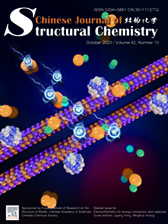
Cover Picture
Modulating metal-support interaction between Pt3Ni and unsaturated WOx to selectively regulate the ORR performance
Jinli Chen, Shouquan Feng, Tianqi Yu, Yongjin Zou, Huan Wen*, Shibin Yin* Submit a Manuscript
Modulating metal-support interaction between Pt3Ni and unsaturated WOx to selectively regulate the ORR performance
Jinli Chen, Shouquan Feng, Tianqi Yu, Yongjin Zou, Huan Wen*, Shibin Yin* Submit a Manuscript
Selective CO2-to-formic acid electrochemical conversion by modulating electronic environment of copper phthalocyanine with defective graphene
Hanqing Zhang, Xiaoxia Wang, Chen Chen, Xianfeng Yang, Chungli Dong, Yucheng Huang, Xiaoliang Zhao*, Dongjiang Yang*
Chin. J. Struct. Chem., 2023, 42: 100089. DOI: 10.1016/j.cjsc.2023.100089
October 15, 2023
CO2RR; CuPc/DG composite; Electron-rich region on Cu atoms; HCOOH selectivity; DFT calculations
ABSTRACT
In the carbon dioxide reduction reaction (CO2RR), the activity of transition metal center depends largely on its electronic structure, since the electronic rich region enhances the adsorption of intermediates at active sites, thus improving the selectivity to reduction products. In this work, we prepared CuPc/DG composite (CuPc: copper phthalocyanine; DG: defective graphene) to achieve selective CO2-to-formic acid (HCOOH) electrochemical conversion through modulating the electronic structure of Cu active centers with DG via π-π stacking. Evaluated as the electrocatalyst, the CuPc/DG composite displays a high faradaic efficiency (FE) of 44.6% −0.78 V vs. RHE for CO2RR to HCOOH. Partial current density is 5.28 mA cm−2 for HCOOH together with an exceptional stability throughout at least 20 h of reaction. On the basis of density functional theory (DFT) calculation results, defects in DG can effectively promote the charge redistribution of dispersed CuPc, where electrons transfer to CuPc from defects, forming rich electronic environment around Cu sites. The abundance of electrons makes the d-band center of Cu approach to the Fermi level and decrease the energy barrier of CuPc/DG composite for the intermediate of ∗OCHO, thus accelerating the reduction of CO2 to HCOOH.







